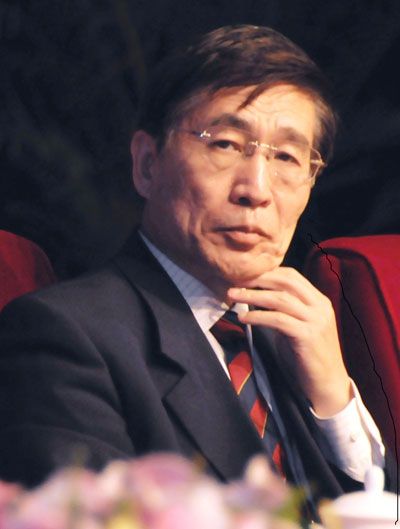Breaching the Great Wall: Major Pharma Changes Proposed in China
With a revision of China’s basic drug approval law now underway, a multinational team of experts is proposing major changes to make the country a world class player in innovation.
With a revision of China’s basic drug approval law now underway, a multinational team of experts is proposing major changes to make the country a world class player in innovation.

Dr. Wang Chenguang, Dean of Tsinghua Law School
Behind the vaulting growth statistics that make China the centerfold in Big Pharma’s global playbook is a sobering fact: registering a new drug for local sale is still a slow, dimly lit game of chance. China’s regulatory approval system has not kept pace with the needs of an expanding local market, relying on opaque, erratically administered procedures known mainly to staff, many of whom lack the scientific qualifications common among drug reviewers in the US, Europe and Japan. You might call it a dated, 20th century pathway to the big market of the future.
A mix of internal reforms, stakeholder insights and foreign pressure has begun to change that. An overhaul of the Drug Administration Law is pending and has been cited as a priority by the Chinese government. In March, the State Food and Drug Administration [SFDA] was reorganized to give drug regulators more independence and a higher profile. The renamed China FDA [CFDA] now reports directly to the government’s top executive body, the State Council, instead of the Ministry of Health, and incorporates several formerly separate bureaus responsible for quality and safety inspections.
The question now is – what next?
In a measure of how much China has changed, stakeholders outside the government have decided to weigh in. The most prominent example is the intensive review of the entire decision-making chain behind new drug approvals in China just completed by a cross-functional multinational team of experts convened by the Pharmaceutical Law Institute of Beijing’s Tsinghua University. The Institute team, led by its chair, Dean of Tsinghua Law School Wang Chenguang, and with tacit encouragement from the leadership of the CFDA and Ministry of Health, has spent the past year examining process and policy in three specific areas:
- Approval and conduct of clinical trials;
- Registration rules and requirements; and
- Institutional functions and capabilities.
Three expert working groups were established around each topic, each led by two rapporteurs, one from China and the other from the US. A combined report – Building a 21st Century Pharmaceutical RegulatorySystem – was released on June 23 at a Pharmaceutical Law Institute event in Beijing hosted by Professor Wang. The event featured the participation of representatives of the new CFDA as well as the State Council’s Office of Legislative Affairs.
A new regulatory roadmap
The report concluded that revision of China’s Drug Administration Law should focus on nine integrated objectives. Highlights include the following:

Ken Kaitin, Director, Tufts CSDD
Improve administrative procedures and put additional resources behind efforts to make China a global center for R&D in innovative medicines, including biologics. Greater clarity in rules for the conduct of local clinical trials and allowance for the use of relevant foreign trial data in registration applications are critical if China is to succeed in developing new drugs that will win approval in the global market. “Currently, a Phase I study sponsored by a multinational company can only be conducted in China if the compound is already registered or undergoing Phase II and III trials in other countries. This discourages these companies from including Chinese sites in multinational clinical development programs, which makes it harder for China to realize its objective to be a leader in the registration of new global innovative drugs,” said Ken Kaitin, Director of the Tufts Center for the Study of Drug Development in Boston and co-rapporteur for the report on clinical trial issues.
Increased transparency and outside participation in the drug evaluation and approval process. This can be done through such measures as advance notices on regulatory actions and the systematic inclusion of industry, academia, patients and other stakeholders in decision-making. Too often, the report says, regulators operate in “campaign mode,” consulting others only as they see fit. An important reference in the report was keeping intact that regulatory “firewall” between the market authorization and “value,” i.e pricing. Such differentiation is fast eroding in the mature country systems.
Harmonization of local approaches to trial management, ethical oversight/compliance, registration applications, manufacturing, patient safety and risk management according to internationally acceptednorms – essentially raising the bar on local performance to better prepare Chinese manufacturers to compete in the global market. The team emphasized that China is currently proficient in producing generic drugs, but if the country wants to move beyond that, with new medicines that innovate for undertreated diseases that distort public health, the regulatory system must change – beginning with these and other related approval procedures.
Bolstering the platform is a strong endorsement of IP rights, in which the report noted that China’s implementation of the WTO TRIPS treaty still lacked “clarity.” The problem of patent linkage was addressed by recommending a new procedure to help originator patent holders ensure CFDA is aware and can respond to infringements by generic producers. Another point was the need to formally confirm that both imported and domestic medicines are eligible for data protection, with advance notice to originators given prior to the registration application.
Improve the institutional capacity and effectiveness of drug regulatory agencies, through actions like better defining the CFDA’s legal status; introducing formal science-based review criteria; creating a clear pathway for accelerated review of the most promising therapies, and applying this equally to domestic and imported drugs; and establishing clear lines of authority between CFDA, other central government agencies with a mandate to maintain public health and – most important – the provincial administrative authorities. At present, the Drug Administration Law fails to set a clear demarcation between the functions and responsibilities of the various regulatory bodies for drugs, and local authorities are subject to strong political pressures that limit their independence. Reliance on independent examiners and experts was also cited as a way to raise the skills base and professional qualifications of regulatory staff, which was profiled as being way below international norms.
Raising the bar on talent
The report provided some interesting data points to buttress this reform agenda. It notes that in China it takes on average a year and a half to obtain approval to launch a clinical trial – the less formal FDA notification process in the US typically takes no more than 30 days. In addition, staffing for regulation throughout China is kept abnormally low by quotas that link hiring to a tiny fraction of the population being regulated. And the professional credentials of regulatory staff lags significantly against the standard in industrialized countries. Only five per cent of CFDA staffers hold a master’s degree or above; 45 per cent of CFDA staffers lack even a bachelor’s degree.
Susan Winckler, President of the Food and Drug Law Institute in Washington, who served in a personal capacity as co-rapporteur for the work group on institutional structure and functions, told Pharm Exec that what is needed to accompany a new Drug Administration Law is adoption by the regulatory bodies of “an internal culture of continuous improvement.” She notes that the challenges facing the Chinese system are actually the same everywhere – it’s simply a matter of degree. “The US FDA is also resource-constrained and is under similar pressure to be more predictable and transparent in the way it operates.” Winckler believes that the Tsinghua project should thus act as stimulus to a broader dialogue to which regulators in all countries can contribute. “Change will come about if that discussion includes not just the regulatory community, but those who are regulated too.”
Project phase II
Looking forward, CFDA officials anticipate that a first draft of a new Drug Administration Law is likely by the end of this year, and it has invited Tsinghua to contribute ideas to help shape the process. In September, the Pharmaceutical Law Institute team will commence a second phase of the project, with three new work streams to address the following topics: (1) pharmacovigilance and risk management standards; (2) a regulatory pathway for biologics, including biosimilars; and (3) legal/product liability reforms. Since the thrust here is to identify and transfer best practices that might prove useful to China, Tsinghua hopes to draw in contributing experts from Europe and other mature countries, in addition to the US.
Overall, continuing the project is timely given recent disclosures on misuse of data in clinical trials and apparently endemic bribery and corruption, at least in some companies. What China needs most is what the Tsinghua project seeks to provide: better governance around what in any country is by definition a complex and difficult process – registering a new drug.
Addressing Disparities in Psoriasis Trials: Takeda's Strategies for Inclusivity in Clinical Research
April 14th 2025LaShell Robinson, Head of Global Feasibility and Trial Equity at Takeda, speaks about the company's strategies to engage patients in underrepresented populations in its phase III psoriasis trials.
Beyond the Prescription: Pharma's Role in Digital Health Conversations
April 1st 2025Join us for an insightful conversation with Jennifer Harakal, Head of Regulatory Affairs at Canopy Life Sciences, as we unpack the evolving intersection of social media and healthcare decisions. Discover how pharmaceutical companies can navigate regulatory challenges while meaningfully engaging with consumers in digital spaces. Jennifer shares expert strategies for responsible marketing, working with influencers, and creating educational content that bridges the gap between patients and healthcare providers. A must-listen for pharma marketers looking to build trust and compliance in today's social media landscape.